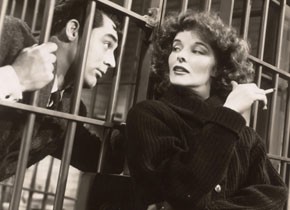Screwball Comedy
December 1, 2008 to January 7, 2009
In December, the Austrian Film Museum turns its attention to Screwball Comedy: a popular branch of American film comedy which is defined not only by its fast pace, witty dialogue and madcap characters, but by an unceasing interest in the battle of the sexes and the reconciliation of love, money and madness (or the failure thereof). Screwball comedies originated around 1934, when the Depression was on the wane and Hollywood was intensifying its practice of self-censorship. Up until the War years, this subgenre accounted for some of the all-time favourites of the Roosevelt era: It Happened One Night (1934), Bringing Up Baby (1938), Bluebeard's Eighth Wife (1938), The Philadelphia Story (1940), His Girl Friday (1940), or The Lady Eve (1941), to name only a few. Alongside the famous examples, the Film Museum has lined up a wide selection of rediscoveries and underrated works by directors such as Garson Kanin, William Wellman, Mitchell Leisen, Jack Conway or Richard Boleslawski.
The show also includes some of the genre’s predecessors – and two attempts to resuscitate the screwball mode after 1945 The etymology is obscure. The most common explanation for the genre’s name stems from baseball, where the trajectory of a screwball pitch is as unpredictable as the zany characters which populate the films in question. It is much easier to specify the social, economical and moral coordinates of the genre. The strengthening of the Hollywood "Production Code" made it impossible to portray sexual content in any but a very oblique fashion. The still candid conversations and erotic triangles in Ernst Lubitsch's sex comedies (such as Design for Living, 1933) would now have to be sublimated in forms of behaviour that were decidedly over-the-top. It is precisely this regressive aspect of many screwball characters that indicates a rebellion against the absurd requirements of the Code. The fact that even married movie couples were only allowed to sleep in separate beds, was promptly parodied in one of the “founding” screwball films of 1934, Frank Capra's It Happened One Night. The same year, Howard Hawks' Twentieth Century allowed the egotistical excesses of childhood to return to full bloom in the milieu of stage actors.
The third screwball success of 1934, The Thin Man, crossed Dashiell Hammett's crime novel with comic, self-assured repartee between men and women. And it showed how the heritage of Pre-Code comedies could be transcribed into a screwball format: seductive glances and insinuations (not to mention much poking-out of the tongue) became the new tools for creating sexual tension. The breakneck (verbal) speed of the earlier films remained, but all cheekiness would now be directed at one's screen partner rather than at social norms; in this respect, the politics of Screwball are more conservative than those of Pre-Code comedy. It Happened One Night comes across like an allegory of the New Deal: Claudette Colbert, the first of many spoiled screwball heiresses, learns to appreciate the merits of the common man, as interpreted by Clark Gable's down-on-his-luck reporter, while he can only propose to marry her when he has proven himself financially. As an independent woman who is every bit a match for her male counterpart yet still ends up choosing the married life, Colbert is the model for many strong-spirited women of the screwball era who were always on the brink of being "tamed" by their partners. The genre excels in the ironic confrontation of such contradictions: poor vs. rich, educated vs. stupid, deceitful vs. honest, well-mannered vs. spoiled brat, and above all: male vs. female.
While Capra was steering his populist Zeitgeist comedies more and more towards drama, Gregory La Cava’s brilliant My Man Godfrey (1936) set the standard for the social screwball comedies of the late 1930s. La Cava treated poverty as a farce – in which a slum-dweller teaches manners to the rich; other films make a topic of the stock market crash (Easy Living, 1937) or single motherhood (Bachelor Mother, 1939). At the same time, Leo McCarey’s The Awful Truth (1937) established the genre’s second offshoot – the "comedy of remarriage": a married couple decides to get a divorce, but at the last moment they realize that there’s more fun to be had when they’re together rather than apart. With Cary Grant in the lead role, Screwball Comedy had also found its quintessential star. Among the genre’s many cherished actors and actresses – Carole Lombard, Katharine Hepburn, Irene Dunne, Barbara Stanwyck, Jean Arthur, Henry Fonda, Cary Cooper, or William Powell – no one was more adept at making an outlandish character or an improbable script appear as fully natural and normal.
During the genre's heyday, Grant had some of his greatest parts – as well as two of his ideal directing partners: George Cukor in Holiday (1938) and The Philadelphia Story, and Howard Hawks in Bringing Up Baby and His Girl Friday. After the onset of World War II, however, the popularity of the screwball mode declined. In his masterpieces The Lady Eve and The Palm Beach Story (1942), screenwriter-director Preston Sturges pushed the conventions he had helped create to such dizzying heights that the genre would never really recover from it. Wartime film production required more serious and patriotic subjects, and George Stevens was one of the few to find successful ways of combining these needs with the old screwball approach (The Talk of the Town, 1942; The More the Merrier, 1943). At the same time, a more conservative idea of womanhood was becoming entrenched, a different kind of “Code” which the madcap heroines of old would not comply with. Despite some individual attempts in the post-war years to raise the flag of madcap comedy once more, Hollywood’s best shot at what the French call amour fou had come to an end.
This retrospective has been made possible through the support of the US Embassy in Austria. It is staged in collaboration with the BFI National Archive (London)
